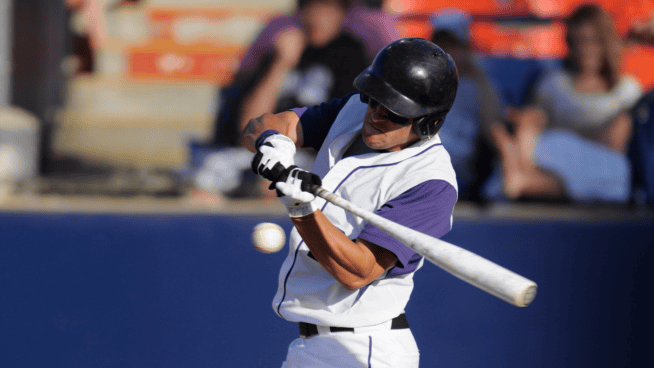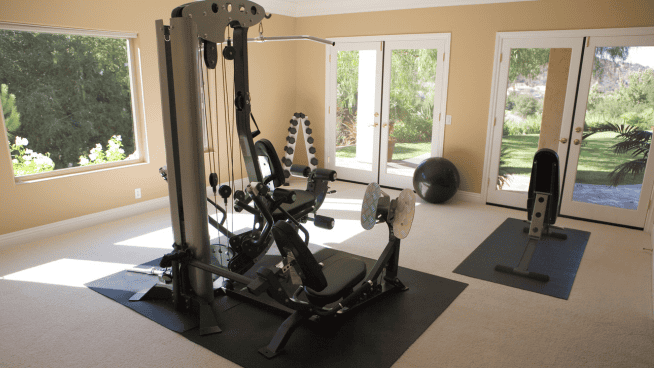7 Tips to Master Single-Leg Exercises
If you’re an athlete, you probably make your living one leg at a time. From sprinting to jumping, throwing to tackling and kicking to shooting, most athletic movements involve some sort of transfer of weight from one leg to the other, requiring a unique blend of strength, balance, stability and coordination. Without these attributes, you’ll end up falling on your rear end rather than blowing by your opponent.
Luckily, single-leg exercises build all these qualities and help your weight room efforts transfer to on-the-field performance. But safe and effective execution of these exercises is easier said than done. Many unilateral lifts are awkward, making you feel more like a baby giraffe than a fleet gazelle. In this article, I provide seven crucial tips to master single-leg exercises and turn you into a beast, even when you’re on one leg.
1. Use a Counterbalance
If Lunges and Split Squats make you feel like you’re lifting on a Slip ‘N Slide, try using a counterbalance. Simply holding a 10-pound plate at arm’s length can provide enough stability to keep you from wobbling.
A counterbalance activates the abdominal muscles, as explained by STACK expert Miguel Aragoncillo in his article, 5 Hacks to Solving Problems with Single Leg Exercises.
2. Start with Reverse Lunges
So you want to start doing Lunges? Throw it in reverse first.
Although it seems natural to lunge forward, stepping backward is actually a bit easier, because your working leg never leaves the ground. You have more control of your working knee and can more easily keep it from caving in or shooting too far forward. Finally, Forward Lunges require a lot more force to decelerate the knee, so if you lack single-leg strength, Reverse Lunges are a great place to start.
3. Use a Half Foam Roller for Bulgarian Split Squats
Bulgarian Split Squats may be the most brutal single-leg exercise in existence. Getting into position is almost as difficult as actually performing the exercise. Holding heavy weight while flailing blindly behind you trying to find your foothold is not exactly fun.
The next time you do Bulgarian Split Squats, try this: take a half foam roller and wrap it around a bench with a stretch band. It will provide a nicely contoured surface for your back foot, making it easier to squat low without foot or ankle pain.
[youtube video=”dpAqAOEIS44″ /]4. Use Band-Assisted Pistol Squats
Pistol Squats can build massive quads, but they require outrageous mobility and coordination to perform. It may take months or years for some people to be able to do a single bodyweight Pistol. To speed up the process, use a band to assist you during the lift.
Wrap a band around the top of a power rack and hold the band tight with your arms close to your body. As you lower yourself, use as little band tension as you need to keep from falling. You can also add a box to sit on, as shown in the video below:
[youtube video=”vAwS7KxeiXE” /]5. Lift Your Toes on Single-Leg Hip Thrusts
Hip Thrusts crush the glutes and hamstrings, promoting more powerful sprints and jumps. But sometimes people only feel them in their quads, especially during the single-leg version. To shift the emphasis to your glutes and hammies, try lifting your toes off the ground while keeping your heels flat. For most people, this immediately targets the correct muscles while taking pressure off the quads.
6. Use a Step for Single-Leg Romanian Deadlifts
Single-Leg Romanian Deadlifts pack a lot of awesomeness into a single exercise. You get a hip hinge (exercise’s most important motion), single-leg balance and a ton of rotary stability. But advancing to this exercise can be tricky. To make it a little easier, try lowering the weight to a step and pausing between reps.
[youtube video=”xWZBsv07IZU” /]
7. Rest Between Sides
It may seem obvious, but many athletes forget that resting before switching to the other leg makes for cleaner reps and better form. When doing single-leg exercises, most people want to switch immediately to the other side; but putting the weight down and taking a breather is a smarter approach.
On a similar note, rather than alternating sides each rep, perform all your reps on one leg, rest and repeat on the other side. This allows you to put full effort into each leg, rather than fatiguing too quickly before finishing either leg.
Sample Single-Leg Workout
To dominate the competition one leg at a time, try this lower-body workout with an emphasis on single-leg exercises:
- A1. Dumbbell Goblet Bulgarian Split Squats – 4×6/side
- A2. Box Jumps – 4×3
- B1. 1-Arm, 1-Leg Dumbbell Romanian Deadlifts – 3×8/side
- B2. Half-Kneeling Cable Chops – 3×10/side
- C1. Single-Leg Hip Thrusts – 3×10/side
- C2. Medicine Ball Deadbugs – 3×6/side
RECOMMENDED FOR YOU
7 Tips to Master Single-Leg Exercises
If you’re an athlete, you probably make your living one leg at a time. From sprinting to jumping, throwing to tackling and kicking to shooting, most athletic movements involve some sort of transfer of weight from one leg to the other, requiring a unique blend of strength, balance, stability and coordination. Without these attributes, you’ll end up falling on your rear end rather than blowing by your opponent.
Luckily, single-leg exercises build all these qualities and help your weight room efforts transfer to on-the-field performance. But safe and effective execution of these exercises is easier said than done. Many unilateral lifts are awkward, making you feel more like a baby giraffe than a fleet gazelle. In this article, I provide seven crucial tips to master single-leg exercises and turn you into a beast, even when you’re on one leg.
1. Use a Counterbalance
If Lunges and Split Squats make you feel like you’re lifting on a Slip ‘N Slide, try using a counterbalance. Simply holding a 10-pound plate at arm’s length can provide enough stability to keep you from wobbling.
A counterbalance activates the abdominal muscles, as explained by STACK expert Miguel Aragoncillo in his article, 5 Hacks to Solving Problems with Single Leg Exercises.
2. Start with Reverse Lunges
So you want to start doing Lunges? Throw it in reverse first.
Although it seems natural to lunge forward, stepping backward is actually a bit easier, because your working leg never leaves the ground. You have more control of your working knee and can more easily keep it from caving in or shooting too far forward. Finally, Forward Lunges require a lot more force to decelerate the knee, so if you lack single-leg strength, Reverse Lunges are a great place to start.
3. Use a Half Foam Roller for Bulgarian Split Squats
Bulgarian Split Squats may be the most brutal single-leg exercise in existence. Getting into position is almost as difficult as actually performing the exercise. Holding heavy weight while flailing blindly behind you trying to find your foothold is not exactly fun.
The next time you do Bulgarian Split Squats, try this: take a half foam roller and wrap it around a bench with a stretch band. It will provide a nicely contoured surface for your back foot, making it easier to squat low without foot or ankle pain.
4. Use Band-Assisted Pistol Squats
Pistol Squats can build massive quads, but they require outrageous mobility and coordination to perform. It may take months or years for some people to be able to do a single bodyweight Pistol. To speed up the process, use a band to assist you during the lift.
Wrap a band around the top of a power rack and hold the band tight with your arms close to your body. As you lower yourself, use as little band tension as you need to keep from falling. You can also add a box to sit on, as shown in the video below:
[youtube video=”vAwS7KxeiXE” /]5. Lift Your Toes on Single-Leg Hip Thrusts
Hip Thrusts crush the glutes and hamstrings, promoting more powerful sprints and jumps. But sometimes people only feel them in their quads, especially during the single-leg version. To shift the emphasis to your glutes and hammies, try lifting your toes off the ground while keeping your heels flat. For most people, this immediately targets the correct muscles while taking pressure off the quads.
6. Use a Step for Single-Leg Romanian Deadlifts
Single-Leg Romanian Deadlifts pack a lot of awesomeness into a single exercise. You get a hip hinge (exercise’s most important motion), single-leg balance and a ton of rotary stability. But advancing to this exercise can be tricky. To make it a little easier, try lowering the weight to a step and pausing between reps.
[youtube video=”xWZBsv07IZU” /]
7. Rest Between Sides
It may seem obvious, but many athletes forget that resting before switching to the other leg makes for cleaner reps and better form. When doing single-leg exercises, most people want to switch immediately to the other side; but putting the weight down and taking a breather is a smarter approach.
On a similar note, rather than alternating sides each rep, perform all your reps on one leg, rest and repeat on the other side. This allows you to put full effort into each leg, rather than fatiguing too quickly before finishing either leg.
Sample Single-Leg Workout
To dominate the competition one leg at a time, try this lower-body workout with an emphasis on single-leg exercises:
- A1. Dumbbell Goblet Bulgarian Split Squats – 4×6/side
- A2. Box Jumps – 4×3
- B1. 1-Arm, 1-Leg Dumbbell Romanian Deadlifts – 3×8/side
- B2. Half-Kneeling Cable Chops – 3×10/side
- C1. Single-Leg Hip Thrusts – 3×10/side
- C2. Medicine Ball Deadbugs – 3×6/side










